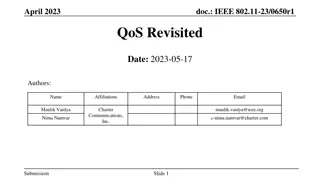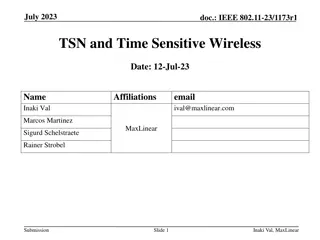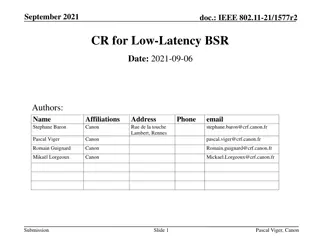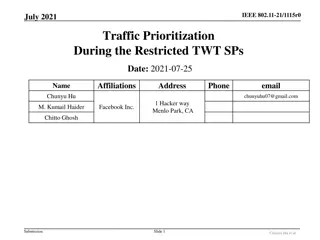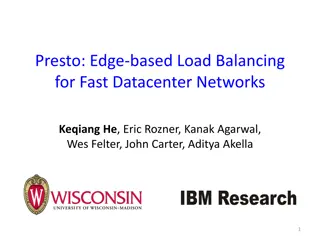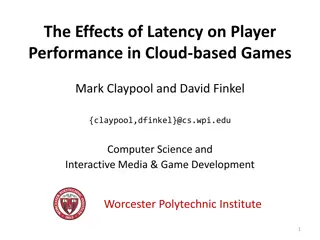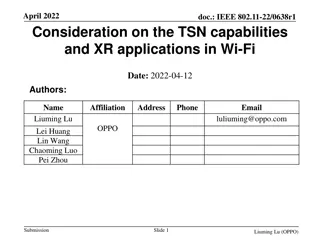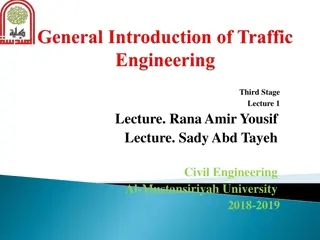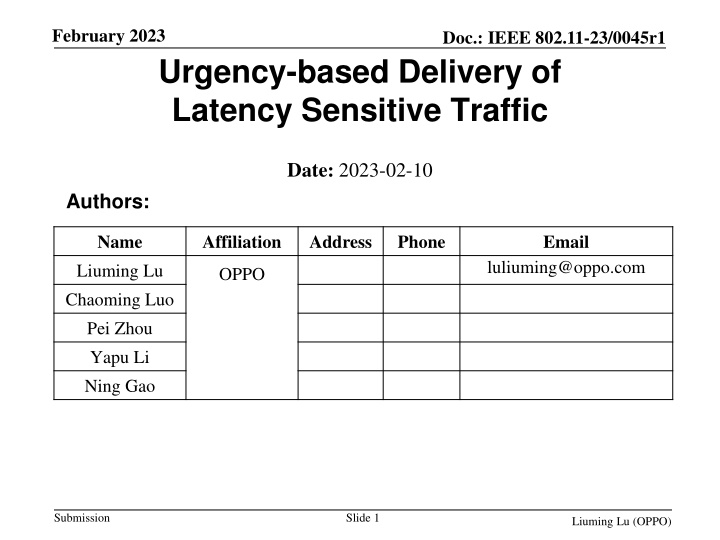
Enhancing Latency-Sensitive Traffic Delivery in IEEE 802.11-23
Explore the advancements in IEEE 802.11-23 for urgency-based delivery of latency-sensitive traffic, addressing limitations, and extending use cases to industrial IoT, smart agriculture, and more. The document discusses improvements in worst-case latency and jitter, challenges in reducing latency, and scenarios for improving overall network performance.
Download Presentation

Please find below an Image/Link to download the presentation.
The content on the website is provided AS IS for your information and personal use only. It may not be sold, licensed, or shared on other websites without obtaining consent from the author. If you encounter any issues during the download, it is possible that the publisher has removed the file from their server.
You are allowed to download the files provided on this website for personal or commercial use, subject to the condition that they are used lawfully. All files are the property of their respective owners.
The content on the website is provided AS IS for your information and personal use only. It may not be sold, licensed, or shared on other websites without obtaining consent from the author.
E N D
Presentation Transcript
February 2023 Doc.: IEEE 802.11-23/0045r1 Urgency-based Delivery of Latency Sensitive Traffic Date: 2023-02-10 Authors: Name Liuming Lu Chaoming Luo Pei Zhou Yapu Li Ning Gao Affiliation Address Phone Email luliuming@oppo.com OPPO Submission Slide 1 Liuming Lu (OPPO)
February 2023 Doc.: IEEE 802.11-23/0045r1 Introduction 11be has taken great effort to define features for improved worst case latency and jitter, such restricted TWT Use cases: virtual reality or augmented reality, gaming, remote office and cloud computing Traffic characteristics: typically shows periodic pattern with burst arrival of packets in each interval (the traffic is referred to as latency sensitive traffic in 11be).[1] The features are beneficial especially for the delivery of the schedulable traffic at lightly loaded BSS with less OBSS interference UHR takes enhanced latency improvement with high reliability as one of main Objectives/KPIs Use cases to be extended: robotics and industrial automation for industrial IoT, logistics, and smart agriculture.[2] Traffic characteristics to be considered: not limited to periodic pattern, may include event- based low-latency traffic which is hard to schedule Scenarios to be extended: improving tail latency and jitter compared to 802.11be including scenarios of overlapping Basic Service Sets (BSSs) and mobility between BSSs.[3] Submission Slide 2 Liuming Lu (OPPO)
February 2023 Doc.: IEEE 802.11-23/0045r1 Limitations of existing features for reducing latency According to currently specified R-TWT operation, the QoS Data frames belonging to specific R-TWT DL/UL TIDs for member R-TWT scheduled STAs during r-TWT SPs are first scheduled for delivery. R-TWT SPs need to be negotiated in advanced between non-AP STA and AP AP schedule the QoS Data frames for low latency traffic based on whether the STA is a member R-TWT scheduled STA, whether the QoS Data frames is belonging to R-TWT DL/UL TIDs expected QoS requirement (such as delay bound) of the traffic provided at the negotiation stage with QoS characteristics element if SCS streams is established Buffer status information by BSRP/BSR (AC/TID-based) Current mechanism cannot dynamically and precisely obtain the urgencies of low latency traffic for the delivery, which would result that the MSDUs pending for urgent transmission can not be delivered timely. the urgency for the delivery of MSDUs refers to whether the delay bound for the MSDU(s) has expired or is about to expire. MSDUs corresponding to different low latency traffic may have different requirements for delay bound. the urgency for the delivery of MSDUs would change as time going on according to the network conditions and whether the BSS is heavily loaded The negotiation of R-TWT SPs would take some time which is not negligible, and for event-based low- latency traffic it is hard to schedule Submission Slide 3 Liuming Lu (OPPO)
February 2023 Doc.: IEEE 802.11-23/0045r1 Scenario example Use cases: HD video, virtual reality or augmented reality Traffic characteristics: periodic pattern, relatively easy to predetermine the QoS characteristics (such as service start time, delay bound, mean date rate, etc.) at the negotiation stage, but the actual values of the QoS parameters may fluctuate in a limited range during the delivery of the traffic Current mechanism: an EHT STA establishes SCS stream with an EHT AP by transmitting an SCS Request frame containing a QoS Characteristics element, which includes a set of parameters defines the characteristics and QoS expectations of a requested traffic flow, such as Delay Bound, Minimum Data Rate, Mean Data Rate, etc. As a reference for the AP s scheduling the QoS Characteristics element just gives the rough data rate of the traffic. For a typical video traffic the real-time bitrate fluctuates between the minimum bitrate and the maximum bitrate, and the difference is non-negligible. Figure. The minimum, average, and maximum bitrates of a typical video stream Submission Slide 4 Liuming Lu (OPPO)
February 2023 Doc.: IEEE 802.11-23/0045r1 Scenario example Issue: for the delivery of latency sensitive traffic during a particular r-TWT SP the QoS Data frames corresponding to the latency sensitive traffic may have different QoS requirements due to OBSS interference and/or increased burst traffic out of schedule especially in heavily loaded BSS, which means that the urgencies for the delivery of the different data frames may change dynamically. AP AP Non Non- -AP STA AP STA initiates the establishment initiates the establishment of latency sensitive traffic of latency sensitive traffic SCS Request(QoS Characteristics element(Direction, TID, Minimum Service SCS Request(QoS Characteristics element(Direction, TID, Minimum Service Interval, Maximum Service Interval, Minimum Data Rate, Delay Bound )) Interval, Maximum Service Interval, Minimum Data Rate, Delay Bound )) SCS Response(SUCCESS) SCS Response(SUCCESS) r r- -TWT Request(r TWT Request(r- -TWT DL TID,r TWT DL TID,r- -TWT UL TID) TWT UL TID) r r- -TWT Response(ACCEPT) TWT Response(ACCEPT) Due to 1) burst traffic increase or 2)OBSS Due to 1) burst traffic increase or 2)OBSS interferences, the traffic which should be interferences, the traffic which should be transmitted during SPi has to be scheduled for transmitted during SPi has to be scheduled for transmission to the next SP(i.e.SP(i+1)). And the transmission to the next SP(i.e.SP(i+1)). And the traffic is relatively urgent for the delivery traffic is relatively urgent for the delivery AP announces r AP announces r- -TWT SPs TWT SPs Trigger Frame Trigger Frame SP1 SP1 Data Frames Data Frames BA BA SPi SPi Frame exchanges Frame exchanges BSRP/BSR frames don t consider the urgency-based BSR information, which would lead to the imprecise scheduling of the delivery of the QoS data frames of latency sensitive traffic. Frame exchanges Frame exchanges SP(i+1) SP(i+1) The end of transmission of The end of transmission of latency sensitive traffic latency sensitive traffic SCS Request (terminate) SCS Request (terminate) SCS Response SCS Response Submission Slide 5 Liuming Lu (OPPO)
February 2023 Doc.: IEEE 802.11-23/0045r1 Candidate Urgency-based BSRP/BSR Urgency-based BSR contains buffer status information of latency sensitive traffic including whether or the amount of the corresponding MSDU(s) or A-MSDU(s) pending for transmission of which the delay bound has expired or is about to expire for the traffic. BSRP is used by AP to trigger urgency-based BSR from non-AP STAs matching given conditions for QoS requirements. Urgency-based BSRP/BSR can help to ensure more urgent QoS data frames for latency sensitive traffic are firstly scheduled for delivery. For scenario of latency sensitive traffic with periodic pattern: more urgent QoS data frames of the traffic are firstly delivered during a restricted TWT SP even in the heavily loaded BSS with OBSS interference. For scenario of event-based latency sensitive traffic with non-periodic pattern: AP can immediately know the urgency-based BSR information for the latency sensitive traffic from non-AP STAs before the schedule of its delivery. Submission Slide 6 Liuming Lu (OPPO)
February 2023 Doc.: IEEE 802.11-23/0045r1 Evaluation of urgency for delivery Evaluation of urgency for the delivery of an MSDU or A-MSDU based on delay bound TimetoDelayExpire(Time to delay expire): specifies the time duration from current time (T1) to the transmission delay expiration time (T2) for an MSDU or A-MSDU with the transmission requirement of delay bound belonging to a traffic flow the transmission delay expiration time (T2) is the time marking the arrival of the MSDU, or the first MSDU of the MSDUs constituting an A-MSDU, at the local MAC sublayer from the local MAC SAP (T0) plus delay bound. T Current Time (T1) the transmission delay expiration time (T2) TimetoDelayExpire TimetoDelayExpire MSDU or A-MSDU MSDU or A-MSDU the transmission delay expiration time (T2) Current Time (T1) T0 + Delay Bound T0 + Delay Bound the time marking the arrival of a MSDU or A-MSDU, at the local MAC sublayer from the local MAC SAP (T0) the time marking the arrival of a MSDU or A-MSDU, at the local MAC sublayer from the local MAC SAP (T0) a)A MSDU or A-MSDU with its transmission delay time having not expired b)A MSDU or A-MSDU with its transmission delay time having expired for an MSDU or A-MSDU in the buffer if its transmission delay expiration time (T2) is later than the current time (T1), its transmission delay time has not expired (denoted as TimetoDelayExpire > 0) for an MSDU or A-MSDU in the buffer if its transmission delay expiration time (T2) is equal to or earlier than the current time (T1), its transmission delay time has not expired (denoted as TimetoDelayExpire 0) Submission Slide 7 Liuming Lu (OPPO)
February 2023 Doc.: IEEE 802.11-23/0045r1 Evaluation of urgency for delivery The urgency for the delivery of MSDUs or A-MSDUs belonging to latency sensitive traffic for different STAs associated with an AP can be measured based on the parameter of TimetoDelayExpire 0<Min(TimetoDelayExpire<Max(TimetoDelayExpire) The queue with the MSDUs The queue with the MSDUs or A or A- -MSDUs belong to r MSDUs belong to r- - TWT TID(s)in STA3 TWT TID(s)in STA3 The delay bound for all corresponding MSDU(s) or A- MSDU(s) pending for transmission has not expired. of the Min(TimetoDelayExpire)<0<Max(TimetoDelayExpire) MSDU or A MSDU or A- -MSDU MSDU max(TimetoDelayExpire) max(TimetoDelayExpire) The delay bound for part of the corresponding MSDU(s) or A-MSDU(s) pending for transmission has expired. The queue with the MSDUs The queue with the MSDUs or A or A- -MSDUs belong to r MSDUs belong to r- - TWT TID(s)in STA1 TWT TID(s)in STA1 min( min(TimetoDelayExpire) ) max(TimetoDelayExpire) max(TimetoDelayExpire) MSDU or A MSDU or A- -MSDU MSDU + + Delay Bound Delay Bound Current Time - - max(TimetoDelayExpire) max(TimetoDelayExpire) min( min(TimetoDelayExpire) ) The delay bound for all of the corresponding MSDU(s) or A-MSDU(s) pending for transmission has expired. min( min(TimetoDelayExpire) ) MSDU or A MSDU or A- -MSDU MSDU The queue with the MSDUs The queue with the MSDUs or A or A- -MSDUs belong to r MSDUs belong to r- - TWT TID(s)in STA2 TWT TID(s)in STA2 Min(TimetoDelayExpire)<Max(TimetoDelayExpire)<0 An example for measuring the urgency for the delivery of MSDUs or A-MSDUs at a specific time (current time) Submission Slide 8 Liuming Lu (OPPO)
February 2023 Doc.: IEEE 802.11-23/0045r1 Candidate Solution Evaluation of urgency for the delivery of an MSDU or A-MSDU (1) Based on TimetoDelayExpire Bound TimetoDelayExpire Bound indicates the range of the urgency for the delivery of MSDUs or A-MSDUs if the current TimetoDelayExpire of an MSDU or A-MSDU is equal to or less than TimetoDelayExpire Bound, it satisfies the condition within the range of the urgency for MSDUs or A-MSDUs in the buffer Queue in the buffer Queue in the buffer MSDUs or A MSDUs or A- - MSDUs belonging MSDUs belonging to r to r- -TWT TID(s) TWT TID(s) the MSDUs or A the MSDUs or A- -MSDUs the current MSDUs the current TimetoDelayExpire of which is equal to or TimetoDelayExpire of which is equal to or less than TimetoDelayExpire Bound less than TimetoDelayExpire Bound r r- -TWT SP1 TWT SP1 r r- -TWT SP2 TWT SP2 (2) Based on whether the transmission delay time expires in a given upcoming time if the transmission delay time of an MSDU or A-MSDU will expire in a given time (i.e. the TimetoDelayExpire of the MSDU or A- MSDU in the given time is equal to or less than 0) it satisfies the condition within the range of the urgency for MSDUs or A- MSDUs in the buffer start time of SP2 start time of SP2 (Tc) (Tc) end time of SP2 end time of SP2 (Td) (Td) start time of SP1 start time of SP1 (Ta) (Ta) end time of SP1 end time of SP1 (Tb) (Tb) Queue in the buffer Queue in the buffer the MSDUs or A the MSDUs or A- -MSDUs the transmission delay time of transmission delay time of which will expire in Tb which will expire in Tb MSDUs the MSDUs or A MSDUs or A- - MSDUs belonging MSDUs belonging to r to r- -TWT TID(s) TWT TID(s) the MSDUs or A the MSDUs or A- -MSDUs the transmission delay time of transmission delay time of which will expire in Tc which will expire in Tc MSDUs the the MSDUs or A the MSDUs or A- -MSDUs the transmission delay time of transmission delay time of which will expire in Td which will expire in Td MSDUs the Submission Slide 9 Liuming Lu (OPPO)
February 2023 Doc.: IEEE 802.11-23/0045r1 Candidate Solution AP schedules the delivery of the QoS data frames of the latency sensitive traffic to ensure that more urgent QoS Data frames are firstly delivered during a R-TWT SP. AP AP Non Non- -AP STA AP STA Initiate the establishment Initiate the establishment of SCS stream for latency of SCS stream for latency sensitive traffic sensitive traffic SCS Request(QoS Characteristics element(Direction, TID, Minimum Service SCS Request(QoS Characteristics element(Direction, TID, Minimum Service Interval, Maximum Service Interval, Minimum Data Rate, Interval, Maximum Service Interval, Minimum Data Rate, Delay Bound Delay Bound )) )) U-BSRP contains the information of the given urgency range, such as TimetoDelayExpire Bound, to trigger the BSR which satisfies the urgency condition. SCS Response(SUCCESS) SCS Response(SUCCESS) r r- -TWT Request(r TWT Request(r- -TWT DL TID,r TWT DL TID,r- -TWT UL TID) TWT UL TID) r r- -TWT Response(ACCEPT) TWT Response(ACCEPT) AP announce r AP announce r- -TWT SPs TWT SPs U U- -BSRP Trigger Frame BSRP Trigger Frame U-BSR contains the BSR information within the given urgency range, such as the buffer status of QoS data frames with the given TID(s) of the latency sensitive traffic, which would expire within TimetoDelayExpire Bound. SP(i) SP(i) Data frame carrying U Data frame carrying U- -BSR information BSR information BA BA Trigger Frame Trigger Frame Data frame carrying U Data frame carrying U- -BSR information BSR information BA BA U U- -BSRP Trigger Frame BSRP Trigger Frame SP(i+1) SP(i+1) Data frame carrying U Data frame carrying U- -BSR information BSR information BA BA Terminate the SCS stream for Terminate the SCS stream for latency sensitive traffic latency sensitive traffic SCS Request (terminate) SCS Request (terminate) SCS Response SCS Response Submission Slide 10 Liuming Lu (OPPO)
February 2023 Doc.: IEEE 802.11-23/0045r1 Summary QoS Data frames corresponding to the latency sensitive traffic may have different urgencies for the delivery due to OBSS interference and/or increased burst traffic out of schedule especially in heavily loaded BSS Urgency-based BSRP/BSR can help to ensure more urgent QoS data frames for latency sensitive traffic are firstly scheduled for delivery. For scenario of latency sensitive traffic with periodic pattern: more urgent QoS data frames of the traffic are firstly delivered during a R-TWT SP even in the heavily loaded BSS with OBSS interference. For scenario of event-based latency sensitive traffic with non-periodic pattern: AP can immediately know the urgency-based BSR information for the latency sensitive traffic from non-AP STAs before the schedule of its delivery. Submission Slide 11 Liuming Lu (OPPO)
February 2023 Doc.: IEEE 802.11-23/0045r1 Reference [1] IEEE 802.11be Draft 3.0 [2] IEEE 802.11-22/1919r4, Considerations on UHR PAR and KPIs [3] IEEE 802.11-23/0028r6 PAR discussion Submission Slide 12 Liuming Lu (OPPO)
February 2023 Doc.: IEEE 802.11-23/0045r1 SP SP : Do you support to specify urgency-based BSRP (U-BSRP) and Urgency-based BSR (U-BSR) for UHR? Submission Slide 13 Liuming Lu (OPPO)

